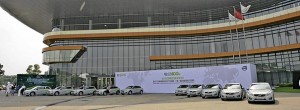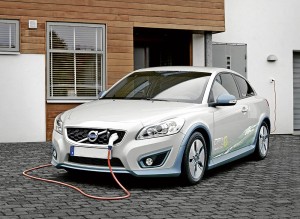China tries out Volvo’s crash-safe electric car
International Automotive City, located at the western outskirts of Shanghai, is much like that portion in Sta. Rosa City in Laguna where automotive companies and allied industries are just a stone’s throw from each other.
Also known as the Shanghai Auto City, SIAC is revving up for accelerated expansion and upgrading, having listed electric vehicles as a crucial component in its strategic deployment.
Within this 10,000-hectare property (to give one an idea, Sta. Rosa City has a
total land area of 5,413 ha), 15 fortunate individuals will be able to “own” for 100 days, Volvo’s greenest car, the C30 Electric.
At first, driving Volvo’s all-electric, four-seat, two-door hatches may seem unimpressive considering there are already a number of electric car models that
have popped up on streets around the world.
But the C30 Electric is probably one of the only few to be certified crash safe, having passed a frontal collision test at 64 kph as well as offset collision test in which 40 percent of the front hit a barrier at 64 kph.
The car has also undergone, and afterward passed, other accident scenario tests such as side collisions and rear-end impacts.
Same high safety level
In all these tests, the C30 Electric prove to offer the very same high safety level that its gasoline counterpart have also earned: The front deformed and distributed the crash energy as expected; both the batteries and the cables that are part of the electric system remained entirely intact after each collision; and power is cut within 50 milliseconds after the collision, at the same time the airbags are deployed.
No wonder this car was declared “Green Car of the Year” in China during the recent 4th China New Energy Mobility Summit, as well as earn its inclusion in the SIAC’s pioneering open road test-drive project called EV100 Days.
The SAIC was one of the Shanghai City government’s key development projects in the 10th five-year development plan period (2001-2005) and aspires to be nothing less than the largest, most complete motor vehicle production and showcasing “city” in the world.
15 C30 Electrics
A fleet of 15 Volvo C30 Electrics will join SIAC’s EV100 real r
oad test-driving, where volunteer test drivers, including popular TV anchors from Shanghai as well as consulate officials from Sweden will drive the electric cars everyday as well
as file a driver journals for three months.
The deployment of these 15 C30 Electrics may be considered significant since SAIC has a unique traffic and road condition as well as climate. The rest of the 250 C30 Electrics are distributed in Sweden, Norway, Belgium, the Netherlands, France, Germany, and the United States.
Volvo in a statement, will use the journals of the drivers to learn more about driving habits as well as how the C30 Electric stands up to rigorous daily traffic and climates.
These experiences will be used by Volvo should the Swedish automaker decides to make a production version of the C30 Electric.

READY for the 100-day test drive: A fleet of 15 Volvo C30 Electrics joined SIAC’s EV100 real road test-driving.
The EV100 trial will also provide Volvo engineers insights on unique issues facing electric car drivers including insurance, maintenance and public charging.
Ideal model
The C30 Electric is part of Volvo’s ambitious electrification strategy. It is an ideal car to be included in the SAIC’s EV100 as the vehicle is well-equipped, comfortable, sporty and safe as its standard counterpart.
In fact, it looks like the regular C30 save for the decals. The difference lies in the weight as well as what could be found underneath.
Because of the two sets of 24-kWh Lithium-ion batteries needed—both tip the scale at 280 kg—the C30 Electric weighs 300 kg more than the standard C30.
Instead of the 227 horsepower 2.5-liter five-cylinder engine, the C30 Electric is equipped with an 82-kW electric motor that generates 110 hp.
This enables the C30 Electric to modestly accelerate from zero to 100 kph in about 6 seconds (same as the standard gasoline-powered C30) and attain a
maximum speed of 130 kph.
150 km on single charge
With a fully charged battery—8 to 10 hours using a 220-volt household socket—the C30 Electric will run 150 km, which is more than enough to get one to Tarlac (129 km), Lucena in Quezon (131 km) if coming from Manila.
Volvo stated that 150 km is a considerably longer distance than 90 percent of all commuters in the world cover per day—the average figure is 45 km/day—which means the C30 Electric could be used for daily commuting.
Interestingly, the C30 Electric is the first Volvo to be fitted with rear brake discs made of lightweight aluminum, which not only contribute in weight reduction but also provide long term reliability (since the brakes are used less
often due to the efficient motor regeneration).
Due to factors such as increased weight and different weight distribution, Volvo’s stability system DSTC has been modified in the C30 Electric to ensure that the battery-powered version has the same high driving pleasure and safety level as the standard C30.
Of course, energy-efficiency is the main reason why the market should be interested in this electric car. Drivers should be glad to know that this electric car is almost four times more energy-efficient than a combustion engine.
If this electric car is recharged using renewable energy (if the community uses wind, hydro, or solar power energy to generate electricity), the C30 Electric produces virtually no carbon dioxide emissions.

